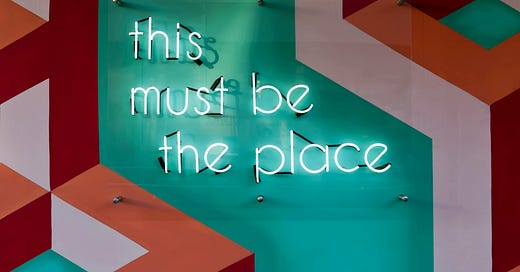⚡Supercharge the Start of Your Team’s Next Offsite
5 Guides Designed to Build Community and Spark Conversation in 1 Hour
Offsites are designed as a time for your team to step away from the day-to-day to think big picture. But, before you dive into the strategy and planning conversations, consider the hook that inspires the start of the day in a unique way. Like a good story, it’s a great opportunity to set the tone with thoughtful conversations, build community and spark inspiration.
I’ve created 5 guides centered around articles I’ve published here. They aim to sharpen key skills to help teams embrace creativity, laughter, failure, unexpected opportunities and resilience. Ask your team members to vote for their top choice to determine what to focus on first.
🍊 Invent an Internal Mascot
😹 Bring Humor to Work
🍔 Learn from The Museum of Failure
🖼️ Create Herman Miller Picnic Poster Moments
🧸 Discover Favorite Children's Books
Before You Begin: These conversations will be different from typical meetings. In advance, identify the experience you want to foster so expectations are clear for the activities. This could include outlining these tenants at the start of the day:Encourage attendees to share their experiences and ideas.
Let’s get creative. Think today in unique ways.
Create a safe space for discussion. What’s said here, stays here.
Emphasize the importance of learning from each other.
The below are high-level lesson plan guides, consider personalizing to your team’s needs. Have fun and let me know how it goes by replying to this newsletter, commenting below or emailing: theswitchboard (at) substack.com.
1. 🍊 Invent an Internal Mascot
Goal: Encourage creativity and team building.
Pre-Read: Read the article. Ask in advance: If we had an internal mascot, what would it be?Intro (5 min) Orangina: Meet Spin’s orange riding scooter
Summarize article: Share 3 top highlights
Ask: What do you think of Orangina and the ways she engaged colleagues?
What mascots do you admire and why? (10 min)
These will likely be external examples, from the M&Ms to Geico, there are many options here.
Mascot Activity Discussion: Small Groups (20 min)
If we had an internal mascot, what would it be?
What is the name of our mascot?
What values do you want our mascot to embody?
What tone do you want our mascot to convey (fun, serious, playful, etc)?
What brand elements (colors, taglines, etc. ) could be incorporated?
What kind of personality do you imagine?
Where will our mascot show up (example: onboarding materials, company events, etc)?
Based on all of the above, sketch your mascot or create a design with your favorite AI tool.
Share Mascots (10 min)
Each team shares their mascots in 1-2 minutes.
Conclude (5 min)
What did we learn from this activity? How might we apply it to our work moving forward?
2. 😹 Bring Humor to Work
Goal: Explore the importance of laughter at work and ways it can be used to build community
Pre-Read: Book Report of “Humor, Seriously: Why Humor Is a Secret Weapon in Business and Life” by Jennifer Aaker and Naomi BagdonasIntro (10 minutes)
Introduce the topic of humor in the workplace and its benefits.
Review key takeaways from the book report.
Ask: "Have you ever had a funny moment at work that brought your team closer together?"
Top 4 Reasons for Embracing Humor at Work (10 minutes)
Ask: Which of these reasons resonates with you the most?
Techniques to Try (10 minutes)
Ask: Which technique would you like to try or have you tried at work?
Group Discussion (10 minutes)
Divide the group into smaller teams. Brainstorm ways to incorporate humor into their workplace.
Encourage teams to share their ideas with the larger group.
Conclude (10 minutes)
Recap the importance of humor in the workplace and its benefits.
Ask: What are you looking forward to trying out to bring humor into our work?
3. 🍔 Learn from The Museum of Failure
Goal: Explore the importance of embracing failure and learning from mistakes at work.
Pre-Read: Read The Museum of FailureIntro (10 minutes)
Introduce the The Museum of Failure and its mission to showcase failed products and services.
Ask: What are common fears or barriers to sharing failures in the workplace?
Ask: What are potential benefits of sharing failures and learning from mistakes in the workplace?
Lessons from Failure (10 minutes)
Ask: Which of these failure stories in the article resonates with you the most?
Ask: Were there other examples that stood out if you reviewed the Museum’s website?
Small Groups: Normalizing Talking About Failure (15 minutes)
Ask: Do you have a moment in your career here or at another organization that you would submit to the Museum of Failure? It doesn’t have to be physical – it can be a story.
Group Discussion (10 minutes)
Encourage teams to share their learnings with the larger group. 1 example per small group.
Conclude (10 minutes)
Recap the importance of embracing failure and learning from mistakes. Use these questions to frame the conversation:
What's one action you'll implement after today when it comes to failure?
How can we use failure stories to inspire innovation and growth?
How can leaders create a safe and supportive environment for employees to share their failures?
4. 🖼️ Create Herman Miller Picnic Poster Moments
Goal: Embrace unexpected projects to lead to unexpected results. The power of being a team player.
Pre-Read: Watch video and read article.Intro (10 minutes)
Introduce the concept of transforming ordinary tasks into extraordinary experiences through the story of Steve Frykholm's picnic poster.
Ask: Have you ever taken an ordinary task and turned it into something special?
Picnic Poster Moments (10 minutes)
Discuss the stories of individuals who transformed ordinary tasks into extraordinary experiences:
Tiffin Jernstedt's archive project
Kevin Lee's honest video
Holly Nicola's newsletter
Caleb Bushner's marketing emails
Ask: What common traits or mindsets do these individuals share?
Applying the Concept (20 minutes)
Ask participants to reflect on their own work experiences and identify an ordinary task that they could transform into something extraordinary.
Encourage participants to brainstorm ways to add creativity and ownership to their task.
Ask: What steps can you take to transform an ordinary task into an extraordinary experience?
Group Discussion (10 minutes)
Divide the group into smaller teams and ask them to share their ideas for transforming ordinary tasks.
Encourage teams to provide feedback and suggestions to each other.
Conclude (10 minutes)
Recap the importance of taking ownership and adding creativity to ordinary tasks.
Ask: "What's one action you'll implement in your work after this discussion?"
How can we cultivate a mindset that sees opportunities for transformation in ordinary tasks?
What project would you aspire to be in the MoMA someday?
5. 🧸 Discover Favorite Children's Books
Goal: Explore the lessons and themes from children's books that can be applied to work communication and relationships.
Pre-Read: Read this article. Choose your favorite children’s book to share with the team.Intro (10 minutes)
Intro the concept of children's books can teach valuable lessons for adults.
Ask: What's a children's book that had a significant impact on you?
Lessons from Children's Books (10 minutes)
Review the selected children's books and their lessons:
Stone Soup: The power of relationships, kindness, and imagination.
The Rabbit Listened: The importance of listening and supporting others.
Goodnight, Goodnight Construction Site: The value of rest and recognizing everyone's contributions.
Hope for the Flowers: Following your instincts and understanding your purpose.
Oh, the Places You'll Go!: Measuring your own success and not relying on external validation.
Ask: Which of these lessons resonates with you the most?
Applying the Lessons (15 minutes)
Ask participants to reflect on how they can apply the lessons from children's books to their workplace communication and relationships.
What are some common themes or lessons that emerged from the children's books?
How can we apply these lessons to our workplace communication and relationships?
Conclude (10 minutes)
Recap the importance of exploring children's books for lessons and themes that can be applied to the workplace.
Ask: What's one action you'll implement in your work after this discussion?
Bonus: Choose 1 children’s book to give to all participants or find out everyone’s favorite book in advance. Give it to each of them and have them choose 1 team member to give the book to.If you draw upon one of these offsite lesson plans, let me know. If you have ideas for other ways to build community at work offsites, share in the comments.
Thank you for tuning into this edition. I’m always grateful for your support growing this community of caring communicators and connectors. If you enjoyed this article, give it a heart, consider sharing it with a friend or posting a learning on LinkedIn. Signing off. — Julia










Music and food serve as powerful "door openers" for building community and sparking meaningful conversations. One approach is inviting teams to create collaborative music playlists and listen together, observing which songs resonate most deeply with participants. Another fun activation is organizing an "unboxing food adventure" where teams receive mystery ingredient boxes and develop a dish without recipes or instructions— problem-solving through culinary collaboration!